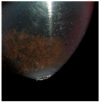Uveal Melanoma Biopsy: A Review
- PMID: 31366043
- PMCID: PMC6721328
- DOI: 10.3390/cancers11081075
Uveal Melanoma Biopsy: A Review
Abstract
Intraocular tumor diagnosis is based on clinical findings supported by additional imaging tools, such as ultrasound, optical coherence tomography and angiographic techniques, usually without the need for invasive procedures or tissue sampling. Despite improvements in the local treatment of uveal melanoma (UM), the prevention and treatment of the metastatic disease remain unsolved, and nearly 50% of patients develop liver metastasis. The current model suggests that tumor cells have already spread by the time of diagnosis, remaining dormant until there are favorable conditions. Tumor sampling procedures at the time of primary tumor diagnosis/treatment are therefore now commonly performed, usually not to confirm the diagnosis of UM, but to obtain a tissue sample for prognostication, to assess patient's specific metastatic risk. Moreover, several studies are ongoing to identify genes specific to UM tumorigenesis, leading to several potential targeted therapeutic strategies. Genetic information can also influence the surveillance timing and metastatic screening type of patients affected by UM. In spite of the widespread use of biopsies in general surgical practice, in ophthalmic oncology the indications and contraindications for tumor biopsy continue to be under debate. The purpose of this review paper is to critically evaluate the role of uveal melanoma biopsy in ophthalmic oncology.
Keywords: biopsy; fine needle aspiration biopsy; metastases; prognosis; uveal melanoma.
Conflict of interest statement
The authors declare no conflict of interest.
Figures










References
Publication types
LinkOut - more resources
Full Text Sources

